Crazy Temples, Golden Triangle, and Hill Tribes
Chiang Rai is the capital of the eponymous northern province of Thailand. Founded in 1262 by King Mengrai, this city with a rich history currently has an official population of 77,000 residents.
While most tourists flock to Chiang Mai, Chiang Rai offers so much: extraordinary temples, art, culture, and nature. From here, you can embark on delightful excursions into the beautiful mountainous region bordering Myanmar, known for its coffee plantations and vibrant ethnic minority communities. Alternatively, you can explore the Golden Triangle, with its unique history as a major opium trading hub. The Hall of Opium provides a comprehensive multimedia presentation of this history.
Chiang Rai is easily accessible by bus from Chiang Mai or by flight from Bangkok or Phuket. Additionally, plans are in place for a railway connection to the northernmost province, extending into Laos.
- Incredible: White Temple – Black Temple – Blue Temple – all in Chiang Rai
- 1000 Cafés
- Parks and Nature around Chiang Rai
- Chiang Rai Hotels, Guesthouses and Hostels
- Chiang Rai Attractions in the Province
- Doi Chang – the coffee mountain
- Chui Fong Tea Plantation
- Doi Tung
- Doi Nang Noon – Tham Luang
- Monkey Temple and Sao Hin Phayanak
- Mae Sai
- Mae Sai Loop
- Golden Triangle
- Chiang Saen
- Phu Chi Fah
- A Request: No Human Zoo Longneck Karen
- On the way to the Chiang Rai attractions
Incredible: White Temple – Black Temple – Blue Temple – all in Chiang Rai
There’s the noteworthy yet relatively conventional Wat Phra Kaeo, which once housed the Emerald Buddha, now enshrined in the identically named Wat in Bangkok. Additionally, there are Wat Phra Singh and Wat Yedyot. Not to be missed is the beautifully renovated Wat Fang Min with the Lanna Cultural Center by the river, where spectacular wood carvings adorn the Lanna-style buildings.
However, Chiang Rai has gained international fame for its extraordinary artworks: Wat Rong Khun (White Temple), Baan Dam (Black House or Black Temple), and the Blue Temple. Artists Chalermchai Kositpipat and Thawan Duchanee have not only left their mark on the art scene but have also created tourist attractions that draw visitors from all around the world.
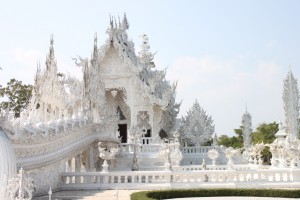
Bright and beautiful – the White Temple in Chiang Rai
One of the biggest tourist attraction in Chiang Rai is Wat Rong Khun – the White Temple: White Temple Chiang Rai
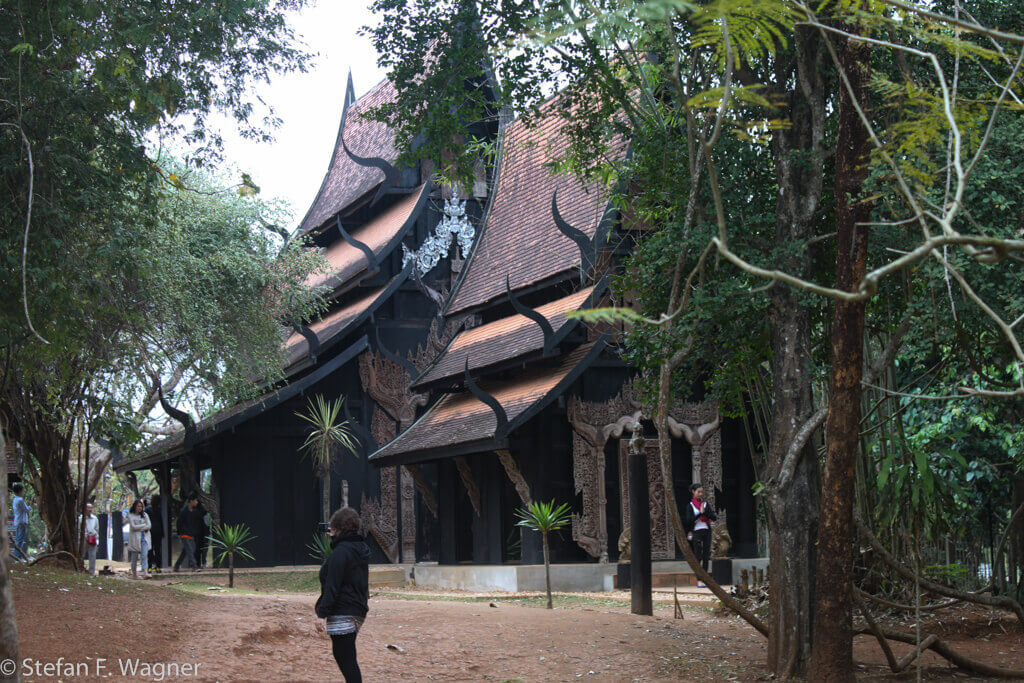
The contrast – Black House or Ban Dam
At the other end of the city – dark, macabre and not less impressive – the Black Temple: Black House Chiang Rai
Riding the wave of creativity, the Wat Rong Suea Ten, also known as the Temple of the Dancing Tigers, underwent a blue redesign. Smaller structures are still being constructed on the premises, all inspired by the White Temple but now adorned in blue.
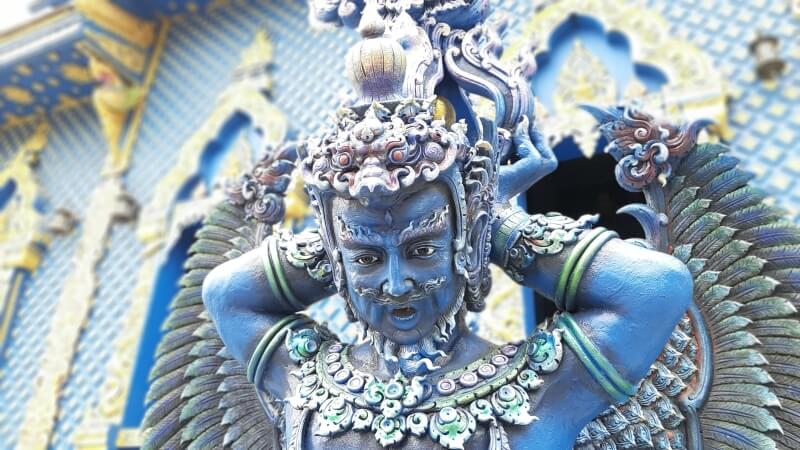
Blue, red, gold – Colour Games in Chiang Rai
After white and black, the tour operators discovered the blue temple, which then became even bluer and the red one even redder. In addition, gold makes the white even more shining … Colour Games in Chiang Rai
The abbot of the small and relatively insignificant Wat Huay Pla Kang had a particularly ambitious vision. Thanks to a generous donation from Taiwan, the construction of the 69-meter-tall statue of Guanyin, known as Big Buddha Chiang Rai, became a reality in 2004. An elevator takes visitors into the head of the statue, which is adorned with reliefs. Through the eyes of the deity, one can gaze out onto the world.
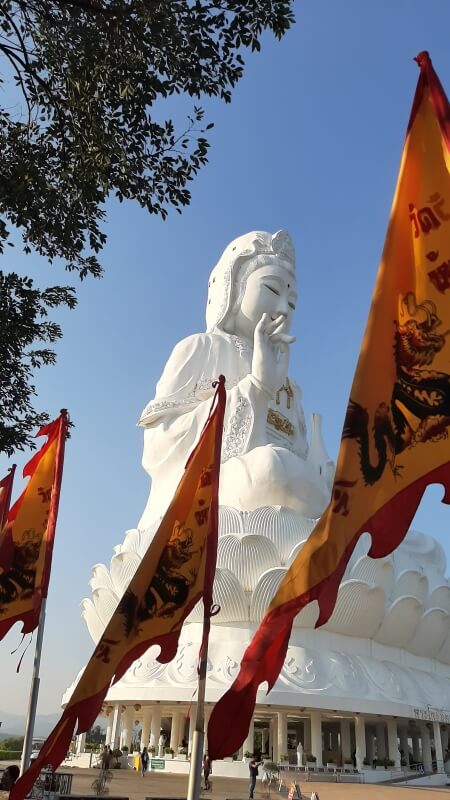
Big Buddha Chiang Rai – the great Buddha, who is none at all
Visible from far away on a hill on the outskirts of Chiang Rai stands a 69 meter high, shining white statue. No wonder that it has become a popular destination for tourists. Wat Huay Pla Kang
It’s worth mentioning the clock tower located in a roundabout at the northern end of Jetyod Road. In the evening, it is illuminated with vibrant colors on the hour, making it a popular subject for photos and videos.
1000 Cafés
“Lanna,” the name of the ancient northern Thai kingdom, translates to “a million rice fields.” One could consider renaming the city to “1000 cafes” because it feels like a new café opens every week. From post-industrial design to rustic shacks, there’s a wide range of options, and most of them serve excellent coffee.
One standout among them is Lalitta Café, situated in front of Wat Huay Pla Kang on the city bypass road. The owner has brought her fairy tale forest dream to life here. It’s a restaurant nestled within a 300-square-meter installation, complete with a 10-meter-high waterfall. It’s delightfully kitschy and artificial, in a way that’s oddly charming. She even mentioned on television that it cost 80 million Baht to build. The entrance fee is 60 Baht for adults and 40 Baht for children, which is credited toward your meal.
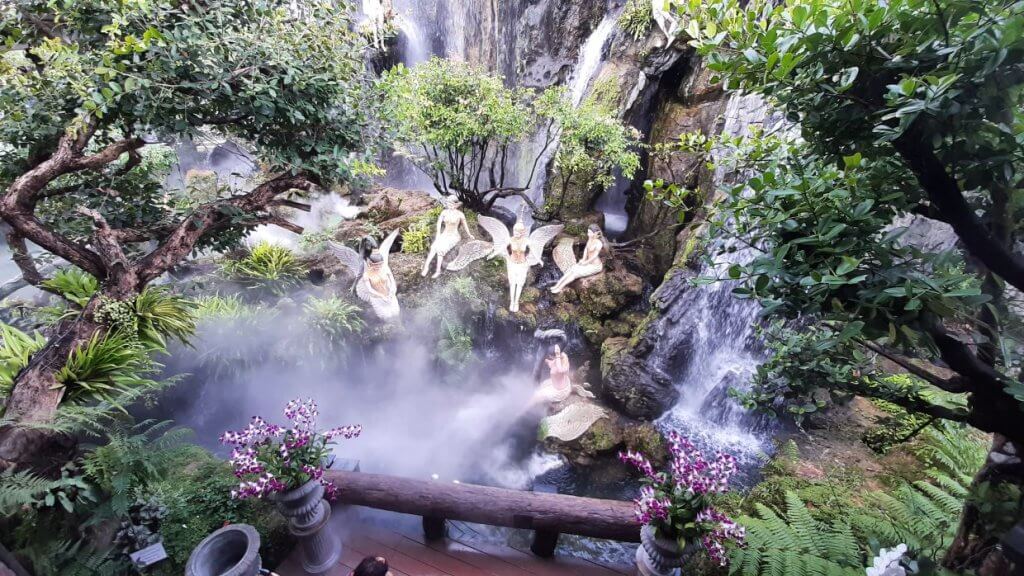
A fairy forest
Life-sized fairies within a waterfall, set amidst a lush jungle – that’s the concept of Lalitta Café… fairies in the waterfall.
Planning a journey to Chiang Rai using public transportation is best done through 12Go. For instance, you can find options for traveling from Chiang Mai to Chiang Rai by bus, van, or taxi, as well as other connections to and from Chiang Rai.
Parks and Nature around Chiang Rai
Worth a visit, especially for families, is Singha Park, located approximately 15 km southwest of Chiang Rai and named after the well-known beer brand. Here, you’ll find small lakes, flower meadows, and cycling paths. There’s also a small zoo featuring African animals. A climbing wall, zip line, and bicycle rental are available for those looking for active pursuits. Entrance to the park is free, and a short bus tour to the zoo costs 100 Baht. The restaurant offers delicious but not budget-friendly dishes. Outside the rainy season, Singha Park hosts a large hot air balloon festival, cycling events, and major concerts.
Remarkably, the park’s iconic golden lion near the entrance is one of the top 50 Instagram spots in Thailand.
A few kilometers further south, the road branches off to the Khun Kon Waterfall. You’ll travel 12 km uphill to reach the National Park campground. From there, it’s another 1.3 km on foot along a jungle trail to reach the beautiful waterfall. Especially at the end of the rainy season, you’ll witness a 12-meter cascade of water. However, even during the dry winter months, it doesn’t run dry, which is a rarity in Thailand.
Also, very beautiful and worth a trip is the Huay Gaew Waterfall upstream in the Lam Kok National Park. Here, the water rushes over the rocks during the rainy season or shortly thereafter, creating a misty spray. The pool is easily accessible via the bridge and rocks, and the cold water is wonderfully refreshing during the hot midday hours.
The hot springs near the National Park campground invite you to warm your feet or even cook a few eggs.
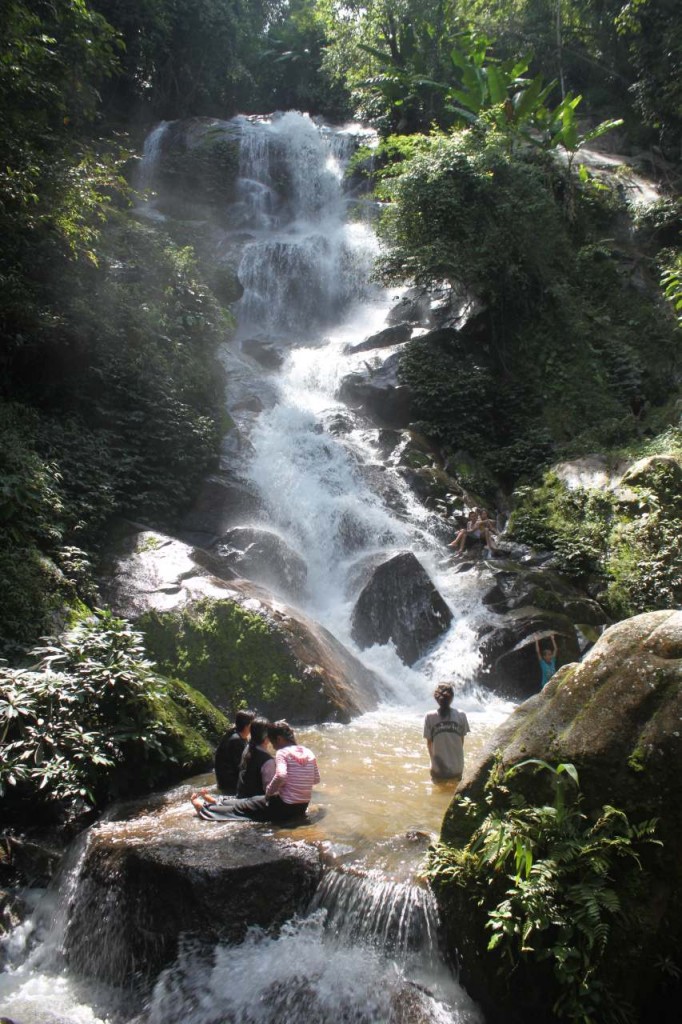
Lam Kok National Park and Huay Gaew Waterfall near Chiang Rai
Just around 20 km outside of Chiang Rai, you’ll find a beautiful national park with hot springs and stunning waterfalls: Lam Kok and Huay Gaew.
Chiang Rai Hotels, Guesthouses and Hostels
I’ve compiled my recommendations for accommodations in the city in an article that covers all price categories. I’m confident you’ll find a lovely place to stay. However, during the high season around Christmas, it’s advisable to book well in advance.
You can find even more information about the city, especially for winter visitors and expatriates, on Chiang Rai Info.
Chiang Rai Attractions in the Province
As mentioned earlier, the city of Chiang Rai serves as an excellent starting point for excursions into the surrounding area. Mae Sai, the northernmost city in the province, is just 60 kilometers away. Whether you book a tour, rent a car, or use public transportation, there is much to discover.
Doi Chang – the coffee mountain
The mountain is mainly inhabited by people from the Akha ethnic minority, who have developed and expanded coffee cultivation on the mountain over two generations. This can be seen in the many, many cafés along the mountain road.
There are two access roads. The easier one via Mae Suai and the more adventurous (and shorter) one from the road that runs along Singhapark.
Chui Fong Tea Plantation
This expansive complex attracts many Thai tourists. I must honestly admit that I’m not entirely sure why because there isn’t much to see. However, it seems that the typical tea plantation patterns, which are also reflected in the logo, provide ample opportunities for photographs.
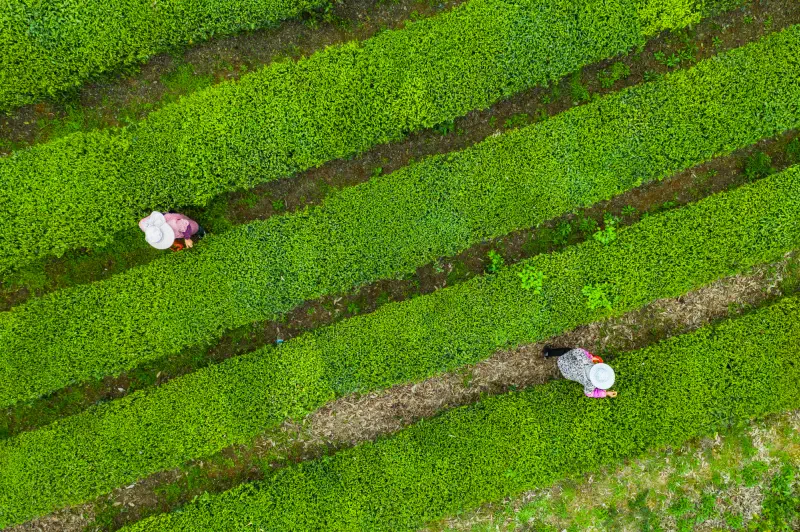
Do you know that you have to register your drone in Thailand?
Let us help you to do that: MyDroneThailand – registration service.
Doi Tung
The highest mountain in Chiang Rai province in northern Thailand is a popular destination for both local and international tourists. Here, you’ll find the famous Mae Fa Luang Gardens and Villa, which serve as a sort of national garden exhibition, along with the royal villa where the highly revered mother of King Bhumibol resided. Today, there is an exhibition showcasing her life.
Wat Prathat Doi Tung is a beautiful temple located at the highest point of the mountain. Instead of driving all the way to the top, I recommend taking the Bell Path from the parking area in the valley.
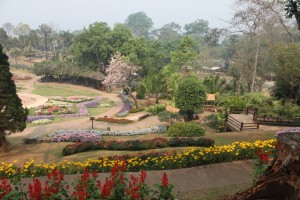
Doi Tung – The Mountain of the Queen Mother
The highest mountain in this region between Mae Chan and Mae Sai is a popular destination for local tourists and people from all over the world. Doi Tung.
Doi Nang Noon – Tham Luang
This mountain range is visible from afar. Like many mountain regions, it is surrounded by a legend of a princess. However, this mountain became widely known because of its cave, Tham Luang. In 2018, an internationally supported rescue operation saved 13 teenagers from this cave. There have since been three movies and a Netflix series depicting this miraculous rescue.
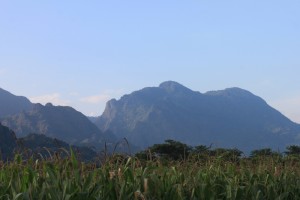
Doi Nang Noon – The Mountain of the Sleeping Woman
Whether you travel to Mae Sai by bus, car, or bicycle, Doi Nang Noon is impossible to miss: the mountain of the sleeping woman.
Monkey Temple and Sao Hin Phayanak
Wat Tham Pla, also known as the Fish Cave Temple, is more popularly referred to as the Monkey Temple. Anyone who visits quickly understands why. As soon as tourists arrive, dozens of monkeys emerge from the trees. Hoping to be fed, they can become quite assertive.
Just a few hundred meters away lies the romantic Sao Hin Phayanak, the Lake of Dragon Pillars. It’s a lake that appears enchanted in the evening or early morning hours, with a bridge leading to the other side where a relatively small, semi-dark cave awaits.
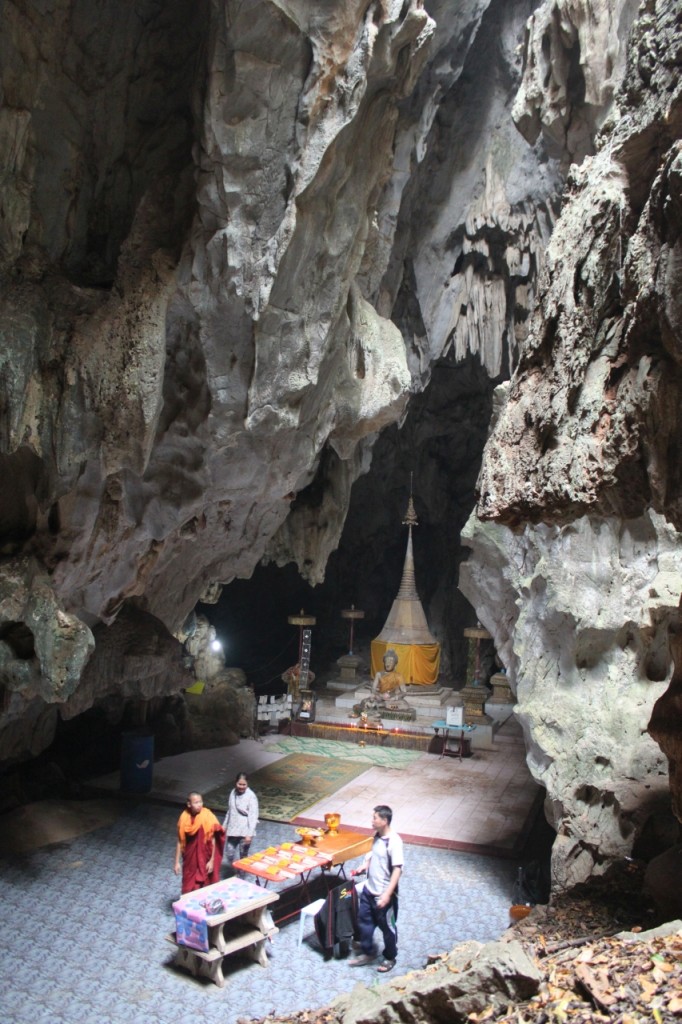
The Monkey Temple – Wat Tham Pla
Tham Pla is a beautiful tourist attraction in Baan Tham, located approximately 12 km south of Mae Sai. Almost every day, you can see tour vehicles from Chiang Rai making a stop here. It’s not surprising because this site offers an extraordinary combination: an ancient temple complex, two very different caves, a pond with fish, and many monkeys. Tham Pla has it all.
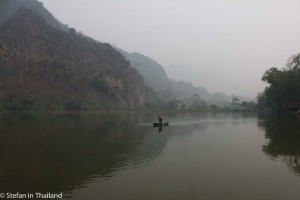
Sao Hin Phayanak – An Enchanted Lake
Sao Hin Phayanak, a truly romantic place, is located very close to the Monkey Temple (Wat Tham Pla, see above). It’s a lake with a cave that appears enchanted in the evening or early morning hours.
My suggestion for organized tours in and around Chiang Rai, Thailand
Mae Sai
The northernmost city in Thailand, with a bustling border crossing to Tachilek, Myanmar, used to be a popular destination. Here, it was relatively easy to do a visa run to obtain an additional 30 days of stay.
Besides a popular photo spot, The Nothernmost of Thailand, many tour operators call it, I find the view from Wat Doi Wao appealing. On the way, you can explore the large market for souvenirs.
For more information about the city and an insider tip for the evening, you can check out Mae Sai Info.
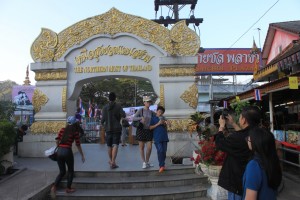
The Northernmost in Mae Sai
The northernmost point of Thailand in Mae Sai is a popular tourist attraction at the border crossing to Myanmar (Burma) and a favorite photo spot for tourists from around the world: northernmost.
Mae Sai Loop
One of the most beautiful trips you can take in Chiang Rai province is the Mae Sai Loop. It connects Doi Tung with its attractions with a drive along the green border and a visit to one of the most beautiful mountain villages in northern Thailand.
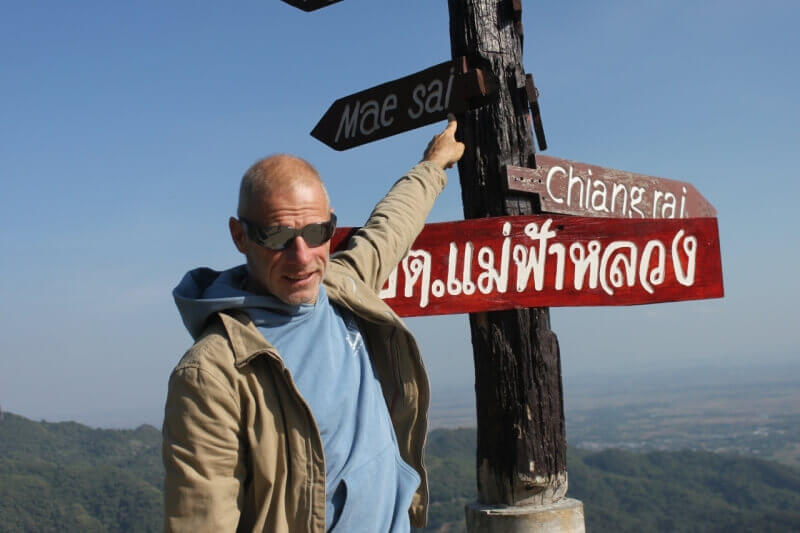
The Mae Sai Loop – the circuit with the scooter or motorcycle.
From Mae Sai, across Doi Tung and through the border mountains to Myanmar. The royals, the military, and coffee. The Mae Sai Loop.
Golden Triangle
Even though the confluence of the Mae Sai River into the Mekong at the tri-border area is called the Golden Triangle by every tour operator, this is actually the name of the region. It got its name because of the opium grown in the area, a history that is very well described in the Hall of Opium.
The giant golden Buddha is impressive, and the elephant statues make for beautiful photo opportunities. The view of the Chinese casino city on the Laotian side is also unique. Gambling is illegal in Thailand.
Chiang Saen
If you like old ruins and a relaxed waterfront promenade, this place on the Mekong is the right choice. From the 10th to the 12th century, Chiang Saen was the capital of a kingdom that extended beyond Phayao. Witnesses to this great era are the remains of an 8 km long city wall and many ruins of ancient temples. A small national museum provides some insight into this time and the customs of the ethnic minorities in the region. Right next to it is the temple ruin of Wat Phrathat Chedi Luang with beautiful photo opportunities.
A few kilometers downstream is Wat Prathat Ngao with a very beautiful wooden temple. A newly built viewing platform with the telling name Mekong Skywalk attracts mainly Thai tourists in the cool season.

Golden Triangle, Hall of Opium, and Chiang Saen
From Mae Sai, a tour is recommended that combines the must-visit Opium Museum, the border point known as the Golden Triangle where Thailand, Laos, and Myanmar meet, and the charming town along the Mekong River. Here is the description: Golden Triangle, Hall of Opium, and Chiang Saen.
Phu Chi Fah
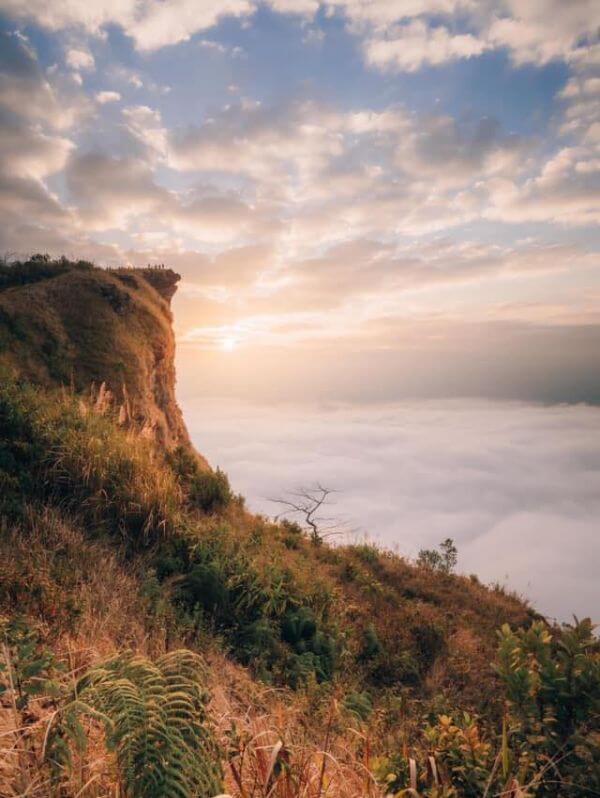
Phu Chi Fah is a highly photogenic mountain peak in the Chiang Rai province, renowned for its breathtaking view of the sea of mist. During the winter, tourists from all over Thailand flock to this destination to witness the sunrise above the clouds. To do so, they wake up very early and head to the Phu Chi Fah Viewpoint.
Here is the description: Border Mountain with Spectacular Views.
Coming Soon: Doi Maesalong
A Request: No Human Zoo Longneck Karen
Visiting a village of the Longneck Karen ethnic minority north of Chiang Rai is on the itinerary of many tour operators. But please think twice about what you’re doing.
You are dropped off in a parking lot, pay 300 Baht for admission, and are then allowed to visit the village with its residents. A few more or less basic bamboo huts serve as the appropriate backdrop for the women with the golden rings around their long necks. They try to sell you some handmade jewelry. You might buy it out of pity. You take a few photos and get back into the minivan or bus. After the bus leaves, life in the village returns to normal. This is like being in a zoo.
On the way to the Chiang Rai attractions
If you’re only in the area for a short time, you should check out the offers from GetYourGuide. Most of them are 2-day tours from Chiang Mai that combine several of the Chiang Rai attractions.
Very often, I also see foreigners riding scooters in the area. It’s a good way to explore the province for experienced riders. You can quickly get used to driving on the left side of the road, but especially for the Mae Sai Loop, you should only attempt it if you can handle steep and narrow switchbacks on rough roads. You can rent scooters in several shops in the city center, especially in Jetyod Road.
Using a comparison portal is a good way to get a comprehensive overview of local rental agencies. Here’s an idea: if you arrive in Chiang Rai by plane, you can rent a car directly at the airport. Then, explore the province and continue your journey to Chiang Mai, where you can return the car.
For transportation to Chiang Rai, you can compare and book various options through 12Go-Asia. This can be particularly helpful during the peak season around Christmas and in January. For example, you can book your journey from Chiang Mai to Chiang Rai through this platform.
You might also be interested in:
MyDroneThailand – Drone registration service
5 Top Tips for SUVARNABHUMI AIRPORT Bangkok
My tips for you: trips in Chiang Rai province
Comparison of Bangkok Airport Hotels